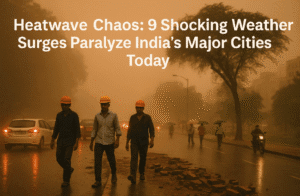Heatwave Chaos: 9 Shocking Weather Surges Paralyze India’s Major Cities Today
On May 10, 2025, India’s urban centers faced a stark contrast of weather extremes, with heatwaves and storms disrupting daily life. Delhi and Mumbai grappled with thunderstorms and high winds under yellow alerts, offering brief respite from oppressive heat, while Kolkata and Bhubaneswar endured temperatures nearing 40°C, worsened by stifling humidity. Hyderabad and Pune baked under relentless dry heat, straining water resources, whereas Bengaluru and Chennai balanced humidity with sporadic rain.
Northern cities like Jaipur and Lucknow saw erratic hailstorms and cyclonic disturbances, damaging crops and infrastructure. Ahmedabad and Patna swung between extreme heat and fleeting rain, highlighting volatile climate patterns. Experts warn of rising pre-monsoon storm intensity and urban heat island effects, urging cities to adopt green infrastructure and emergency preparedness. Residents are advised to prioritize hydration, monitor weather alerts, and safeguard vulnerable groups as India navigates this dual weather crisis.

Heatwave Chaos: 9 Shocking Weather Surges Paralyze India’s Major Cities Today
As India grapples with the intensifying summer of 2025, its major cities face a volatile mix of extreme heatwaves and unseasonal storms. This juxtaposition of weather extremes underscores the growing climate challenges urban centers must confront. Here’s an in-depth look at today’s conditions, expert insights, and actionable advice for residents.
Regional Breakdown: Weather Patterns and Impacts
Delhi: Pre-Monsoon Thunderstorms Offer Respite
The capital is under a yellow alert as thunderstorms and light rainfall disrupt sweltering heat. Temperatures hover between 28°C and 40°C, with humidity exacerbating discomfort.
- Why This Matters: These storms, part of pre-monsoon activity, are triggered by western disturbances colliding with humid winds. While they briefly lower temperatures, they also cause power outages and traffic delays.
- Expert Tip: Dr. Anika Roy, climatologist, advises, “Avoid open areas during thunderstorms and stay updated via IMD’s mobile app for real-time alerts.”
Mumbai: Coastal Winds and Rainfall
High winds (up to 40 kmph) and sporadic rains hit the city, offering temporary relief from heat. However, fishermen are warned against venturing into turbulent seas.
- Context: Arabian Sea moisture fuels these storms, typical of May. Last year, similar conditions caused flooding in low-lying areas like Sion and Matunga.
Kolkata & Bhubaneswar: Relentless Heat
Kolkata’s mercury soars to 39°C, while Bhubaneswar faces 37°C with minimal rain. Humidity levels above 75% amplify heat stress.
- Health Advisory: Hospitals report a 30% spike in heatstroke cases. Carry water, wear breathable fabrics, and avoid direct sunlight between 11 AM–4 PM.
Hyderabad & Bengaluru: Dry Heat vs. Humid Days
Hyderabad endures a dry 40°C, straining water supplies. Bengaluru, at 34°C, battles humidity, with rain expected mid-week.
- Local Impact: Hyderabad’s construction workers are adopting split shifts (6–10 AM and 4–7 PM) to avoid peak heat.
Chennai & Pune: Contrasting Coastal and Inland Trends
Chennai’s 35°C and 77% humidity reflect typical coastal weather, while Pune’s 40°C scorcher highlights inland heat retention.
- Innovation Spotlight: Pune’s municipal corporation tests reflective roof coatings in slums to reduce indoor temperatures.
Jaipur & Lucknow: Unpredictable Storms
Jaipur sees rain and hail, damaging crops but cooling the air. Lucknow’s cyclonic disturbance triggers abrupt storms, uprooting trees.
- Farmers’ Plight: Rajasthan’s hailstorms have devastated mango crops, raising concerns about price hikes.
Ahmedabad & Patna: Extreme Weather Swings
Ahmedabad swings between 31°C and 43°C, with heatwaves straining power grids. Patna’s brief rain respite ends, reverting to 42°C.
- Policy Response: Gujarat launches nighttime cooling centers for outdoor laborers.
Broader Implications: Climate Trends and Preparedness
This year’s weather aligns with studies showing a 15% increase in pre-monsoon storm intensity over the past decade. Rising urban heat island effects, compounded by deforestation and concrete sprawl, exacerbate city temperatures.
- Dr. Rajesh Kapoor, Environmental Scientist: “Cities must invest in green infrastructure—vertical gardens, water bodies—to mitigate heat. Early warning systems for storms are equally critical.”
Actionable Advice for Residents
Heatwave Safety:
- Hydrate frequently; consume electrolytes.
- Use curtains/fans to cool homes without AC.
- Recognize heatstroke symptoms: dizziness, rapid pulse.
Looking Ahead
While storms offer fleeting relief, long-term solutions are vital. Climate-resilient urban planning and community awareness can reduce vulnerabilities. For now, staying informed and adapting daily routines remain the best defense against India’s weather extremes.
You must be logged in to post a comment.